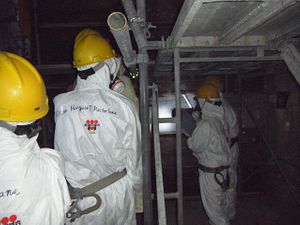Tokyo Electric Power Company (TEPCO), the embattled owner of Japan’s crippled nuclear reactors, has said it is running out of space to store water contaminated with radioactive materials and is proposing to treat the water and dump it in the Pacific Ocean.
Up until now, TEPCO has been storing radioactive water in giant storage tanks on the site of its Fukushima reactor. But groundwater continually flowing into the reactor site becomes contaminated as it does so. Containing and storing an ever-increasing volume of contaminated water is a bit like running on a treadmill – new groundwater becomes contaminated just as TEPCO succeeds in removing previously contaminated water. Meanwhile, the storage tanks multiply around the reactor complex.
In June, TEPCO began construction on what it hoped would be a more permanent solution – an “ice wall.” This is how it is supposed to work: TEPCO would insert 1,500 pipes into the ground around the damaged reactors. It would then flow liquid through the pipes at -30 degrees Celsius, which would freeze the soil. That way, as groundwater rushed downhill towards the complex, the ice wall would block the water from flowing underneath the plant.
Separately, TEPCO is trying to freeze the contaminated water that has leaked directly from the reactor buildings into underground trenches. In total, a staggering 11,000 metric tons of water containing substances like uranium and plutonium has accumulated. TEPCO has thus far failed to freeze the contaminated water, and had to resort to dumping ice onto the site in an effort to freeze the area.
Now the company has admitted that it can’t keep up. So it wants approval from the Nuclear Regulatory Authority to pump out the water, treat it, and begin dumping it into the Pacific.
“We know we have to get an agreement from the relevant government authorities, the prefecture and local fishing unions,” a TEPCO spokesman said recently.
But pushback from the public could present a problem. “We would never consider dumping the water into the ocean unless we received the consent of local residents,” the TEPCO official told the Asahi Shimbun. “The water close to the plant buildings is already contaminated. Fishermen are sure to raise objections to the plan, so it will be difficult to gain their understanding.”
The Nuclear Regulatory Authority (NRA) has been critical of the company for not solely focusing on the contaminated trench water – which it says should be the highest priority – but spending resources on issues with lower priority.
“The biggest risk is the trench water. Until that matter is addressed, it will be difficult to proceed with other decommissioning work,” Shunichi Tanaka, NRA chairman said at a news conference, according to the Wall Street Journal. “It appears that they are getting off track.”
Controlling, treating, storing and disposing of contaminated water is the most critical task in the near-term. Even if that can be resolved, the next step will be actually decommissioning the destroyed reactors – a colossal engineering challenge expected to take 40 years and cost more than $15 billion. Nothing like it has ever been done before; indeed, the task is so unprecedented, it will require robotics that haven’t been invented yet.
But first, TEPCO has to find a place for its toxic water.
This article was originally published at OilPrice.com. It is reprinted with permission.

































